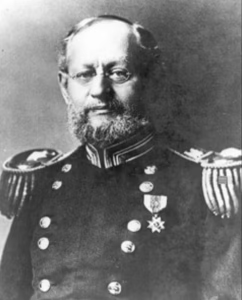The Texas History Minute focuses on Brigadier General Henry Martyn Robert, a prominent figure in the engineering field, particularly known for his role in the construction of the Galveston seawall following the catastrophic hurricane of 1900.

This disaster had a profound impact on Galveston, which was once Texas’s most vital port city. After the hurricane, which resulted in significant loss of life and extensive destruction, the city faced the daunting challenge of rebuilding. Residents recognized the urgent need to prevent such a disaster from happening again, leading to plans for a seawall to protect against future storms.In response to this need, a board of engineers was established, comprising Robert, Alfred Noble, and H.C. Ripley. Their mission was to devise strategies for safeguarding Galveston from future hurricanes by constructing a seawall and raising the city’s elevation. The board presented its recommendations in January 1902, advocating for a seawall that would rise 17 feet above mean low tide and stretch over three miles along the coast.
Galveston, once the most significant port city in Texas, endured a devastating catastrophe during the hurricane of 1900. When the storm subsided and the extent of the destruction became apparent, the city was faced with the monumental challenge of rebuilding. The surviving residents recognized that one of their top priorities was to prevent such a disaster from occurring again. This led to the decision to construct a seawall along the coastline to protect the city from future storms. To oversee this critical project, Galveston enlisted a team of top engineers, headed by Gen. Henry Martyn Robert, a highly regarded figure in engineering at that time.
The precise death toll from the 1900 hurricane remains uncertain. Many individuals fled in the aftermath, while others were swept out to sea, leaving their fates unknown. Estimates suggest that as many as 8,000 people lost their lives, with an equal number left homeless. The entire city lay in ruins; it was rendered nonfunctional, leading to a near collapse of local governance. After order was restored through a newly established commission form of government—the first of its kind in the nation—the city initiated efforts to build the seawall, which demanded immense creativity and labor. Gen. Henry M. Robert accepted this significant responsibility.
Born in 1837 on the southern tip of South Carolina’s Atlantic coast, Robert was raised by a father who was a preacher and educator known for his abolitionist views. This led the family to relocate from South Carolina to Ohio. In 1853, Robert was appointed to the U.S. Military Academy at West Point, where he excelled academically in engineering and graduated in 1857 with a lieutenant’s commission.
As part of the Army Corps of Engineers, Robert’s responsibilities included constructing military fortifications and improving rivers and ports. His early assignments took him to locations like Vancouver, British Columbia, where he worked on fortifications amid rising tensions related to a border dispute known as the “Pig War.”
The Civil War marked a pivotal phase in Robert’s career as he designed and maintained defensive structures for Washington D.C. and Philadelphia while enhancing defenses for New England ports against potential Confederate attacks.
Post-war, he focused on river improvements in Washington and Oregon and spent six years enhancing harbors along the Great Lakes before working on locks and dams on Tennessee and Cumberland rivers.
While accustomed to military protocol, Robert faced challenges managing civilian meetings. After experiencing chaos during a harbor improvement meeting in New Bedford, Massachusetts, he researched parliamentary procedures to improve future gatherings. His findings culminated in a widely recognized manual known as Robert’s Rules of Order.
In 1895, he joined the Board of Engineers overseeing the Corps of Engineers until 1901, where he explored methods to deepen the Mississippi River for better traffic flow. He concluded his military career as Chief of Engineers but retired shortly after his promotion in April 1901.
In 1901, Galveston invited him to lead a team of engineers—including Alfred Noble and H.C. Ripley—to design and construct the seawall with funding from city, county, and state sources. The seawall was built using wooden pilings and concrete after thorough examination by Robert and his team. They also recognized that raising the entire city was essential; thus, every building was elevated by eight feet using available dirt and debris—a labor-intensive process completed by hand.
Construction on the first mile of seawall began in October 1902; by July 1904, it extended 3.3 miles along the Gulf Coast at a height of 17 feet.
The seawall faced its first major test during the hurricane of 1915—a storm comparable in strength to that of 1900—which struck directly but caused minimal damage behind the wall. This success helped Galveston regain its status as a prominent tourist destination by the 1920s.
Gen. Henry Martyn Robert passed away at his home in western New York in May 1923 at age 86. Meanwhile, his rules for conducting meetings have become standard practice across civic organizations and governmental bodies worldwide.
Between 1904 and 1963, extensions were made to the seawall, ultimately reaching ten miles long. Ongoing discussions about enhancing this barrier have arisen due to erosion issues and increasingly severe hurricanes. Despite facing numerous storms over the past century, the seawall has consistently protected Galveston from some of nature’s most dangerous tempests.
No Comment! Be the first one.